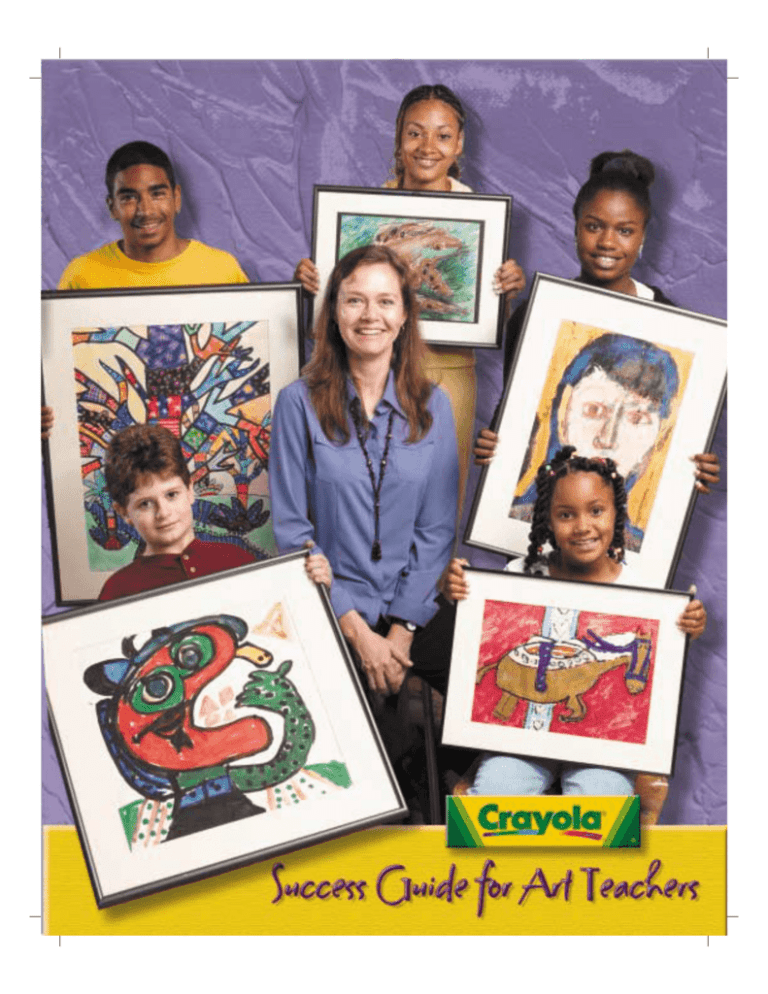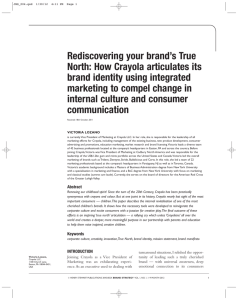Art Teachers
advertisement

Envision the day when your education brings you before children to inspire imagination, to instill knowledge and to guide your students toward success in learning through the arts. Successful students are often a reflection of a successful teacher. However, with the many challenges that face the art teacher today, discovering practical tips and advice that contributes to successful results is as vital to survival as finding an oasis in the desert. During my 27 years of teaching art at all levels, I realized that relationships play a crucial role in assuring success. Mentoring by veteran art educators especially was a powerful factor in my experience as a new art teacher. A supportive college professor, a parent volunteer, and a principal who understood my professional development needs were key lifelines and provided the help I needed to make it all work. Finally, practical counsel on how to navigate the art budgeting process helped me surmount an annual challenge. This guide is a product of personal experience, the contributions of veteran teachers across the country, and Binney & Smith’s interest in the success of all teachers. Binney & Smith has been part of the Education community for more than a century through the Crayola® brand. Parallel to our longterm mission of providing quality art materials for children, in schools and at home, is our commitment to support educators through national programs, advocacy and partnerships with schools, arts and education organizations, and legislators. This printed guide is complemented by more extensive material that can be found on the Educator section of Crayola.com. If you find this guide useful, I encourage you to visit www.Crayola.com/successguide to access this additional material and to make creativity and imagination part of your everyday life. If we can help teachers succeed, then we help children thrive, and the world is a better place because of all of our efforts. Creatively yours, Ron DeLong Manager, Art Education, Educational Curriculum Binney & Smith The Importance of Support W e all know that learning takes place in a social environment. Students grow and learn through interaction with their peers as well as their teachers. By the same token, teachers are a community of learners who deserve access to the most effective methods and materials to further their own growth and the growth of their students. Yet teachers often feel isolated in their classrooms. Our challenge is to create a community of educators, where creative ideas are shared, and both teachers and students benefit. There are several strands from which this community of educators is woven. Most important are face-to-face interactions with veteran teachers, parents, and the principal of your school. Others include membership in state and national professional art education associations such as NAEA, The Arts Education Partnership, Americans for the Arts, ongoing contact with college professors and administrators, and local community influentials. Once a teacher has developed solid relationships with these key groups, there are critical areas of knowledge and fields of endeavor in which they can and should be used. These include developing a mission statement, publicizing your art program, creating a parent organization, navigating the purchasing process, managing the art room and engaging in professional development. Working with Veteran Teachers A common mistake made by new teachers is assuming that you are supposed to have the answers and be able to do it all from day one. On the contrary, the best way to assure your success and that of your students is to accept that you have a lot to learn from more experienced teachers, and that you don’t need to reinvent the wheel. Every district has its stars– model teachers whose strategies and skills should be replicated. These seasoned teachers can coach new teachers: • To become better observers of their students and refine their teaching practices • To navigate the bureaucracy of their school, district and state organizations • To put curriculum guides into practice with standards-based art lessons • To jumpstart curriculum development by sharing standardsbased materials • To become skilled in classroom management, dealing with bureaucracy, and making do with fewer resources. How do you access these invaluable benefits? Just ask. The best veteran teachers are willing to share, to observe, and to be observed. If need be, go outside your district to observe “best practice” sites and the teachers who have developed them. Do not overlook the benefits of joining a professional state or national art education association. Participating in activities and using resources empower teachers to create a vital and self-sustaining community of educators. Through associations, teachers can learn to manage common problems such as dealing with parents and working through mid-year weariness and fatigue. They can also pick up invaluable experience in leveraging research for advocacy and generating publicity for art programs. And if your program or budget are threatened, associations can be invaluable allies. Working with Parents P roving once again that you don’t need to do it all by yourself, parents (and grandparents) can be your greatest resource. They will generally respond when asked to help at home or play a role in the art classroom, but it is up to you to make known the needs of your program. Hold a parent meeting to discuss your art program, and use it as an opportunity to invite participation – identify their areas of expertise and let them draw on their strengths, skills and access to resources. For example, a parent in the construction business can provide scrap wood, or one with networking skills can help organize other parents. Address parents’ concerns head on. If you are taking a pedagogical approach that raises questions, try to show parents the benefits of your methods and explain your reasoning to them. Let parents know how they can reinforce art learning at home. Create an Art Booster Club One art teacher found a way to maximize parent involvement in his art program by creating an Art Booster Club. He first got approval from his supervisor and made sure that he followed district guidelines in working with parents as volunteers. He involved the group in decision-making and identified parent Chairs who could schedule meetings and supervise volunteers in the school and community. At his suggestion, the Chairs created a directory of contacts, including other parents, local artists, local arts agency staff, key community leaders and news outlets. The group used the directory to solicit support for various art projects, activities, artists-in-residencies and assemblies. Publicizing the program brought greater support for the arts in his school and district, and increased the pride his students felt in their accomplishments Engage Helping Hands Other ways parents can help, even without a formal group, include: • Helping with projects that require extensive adult supervision • Assisting with hands-on art activities and remedial assistance (but keep in mind that all parents may not possess the language and knowledge of the artist) • Creating signs, posters and teaching resources, including text signage of art standards to display along with the art you exhibit Working with Principals, Art Supervisors & Curriculum Coordinators At some time in their careers, most principals were first-year teachers; they have a history that can prove valuable to you. Keep a dialogue open with your principal. If you don't see eye-to-eye on issues, make every effort to find a compromise. A successful principal is the result of successful teachers. When interacting with a principal, be mindful of the larger educational picture—how your program fits into the school’s mission, and how your initiatives contribute to the standing of your school and district. Creating a Powerful Bond N ew art teachers who develop a positive bond with their principal derive benefits that last them well past their first year on the job. A supportive principal can play a key role in helping a teacher find a mentor, engage in professional development, and make full use of planning time. In addition to giving teachers formal opportunities to learn and collaborate, principals boost morale simply by taking time to work alongside new teachers. Additionally, experienced art teachers say that evaluations go more smoothly when principals visit classrooms beforehand. That way, art teachers are more at ease and can concentrate on their work with less nervousness. One art teacher found increased support for her program by keeping her principal engaged with her students’ work. She invited her principal to participate in one of her lessons. Although her principal did not have the comprehensive art background she herself possessed, by engaging him as an active learner, she was able to communicate the value of her approach. In addition, she arranged for the exhibition of student artwork in and around the school office. Each work was identified with the student’s name, age, artist’s statement, and the art standard met through the lesson. This effort not only delighted everyone who passed through the office, but helped colleagues, school staff and visitors understand that she was teaching a core academic subject that met required standards in her boardapproved curriculum. Working with College and University Education Professors T eachers don’t stop learning when they graduate, nor does a higher education program lose its relevance or obligation to instruct once it grants a degree. Graduates can continue to benefit from their college programs by following up with institutions and individual professors. Colleges can put new teachers in contact with superior mentors, retired art teachers, and recent graduates who can share experiences. They can often provide ongoing professional development opportunities, contacts with practicing artists, and extended hands-on classroom management. Most importantly, higher education programs can keep teachers connected to the latest research relevant to their area of specialization. By the same token, like all learning environments, higher education programs are dynamic and thrive on feedback from their graduates. Programs—and pre-service teachers—benefit when recent graduates provide feedback on how they are doing, what challenges they are encountering, and how well they feel they were prepared by the classes that they took. New teachers who return to campus after graduation and describe their professional experiences can provide a tremendous service to pre-service teachers. Create Useful and Lasting Partnerships One new art teacher found value in developing a relationship with a local college’s education program, even though she attended a different institution. She was able to network with other recent graduates and ask professors about new opportunities, tactics and strategies that helped her with her teaching. She found that the local college offered an expanded range of professional development options and, through its own network of graduates, made contact with an exemplary art program in a nearby district which helped her improve her own program. Budgets can be worrisome for both new and seasoned art teachers. Funding is often inadequate for the supplies needed to meet curriculum demands. This can be the greatest obstacle to the success of a program, and often the one for which new teachers feel least prepared. However, attending to several key steps in the process can help alleviate anxiety about this basic task of teaching. 1. Get a Head Start Your professional art organization’s annual convention catalogue lists national distributors for art supplies. Call and order print catalogs, or go online to visit distributor and manufacturer Web sites. Remember that the quality of supplies has an impact on the end result of your students’ work. Get the information you need about performance and safety from your distributor or manufacturer. 2. Understand the Process in Your District Learn how your district handles the supply process. Find out who makes the purchasing decision—it might be you, your principal, or a purchasing agent. There may be a warehouse for all your supplies; or you may use a combination of warehousing and direct purchase from a catalog. There might be a district, state, or cooperative bid process, in which case you will need to learn how to get products specified on a bid list. 3. Take Inventory Inventory the existing equipment and consumable supplies in the art room and assess their quality, safety, value and performance. Sometimes you will discover old supplies that may not be safe; since you are responsible for the safety of the classroom, you must keep current safety information accessible in your room or the central office. 4. Decide What You Need to Buy Make a list based on your instructional process and the funding available. Think about what materials can be obtained through scavenging or donation from parents and other teachers—beads, yarn, cardboard, fabric, wallpaper, containers, etc. Try to get recycled materials/castoffs from local businesses to provide you with regular supplemental materials. Save your valued dollars for core products, “must purchase” items only. 5. Track Expenditures Keep track of annual expenditures, and compare this history to district spending on other programs to expose any disparities. Point out to district leaders that the arts are a core subject according to the U.S. Department of Education and should be adequately funded. Talk to colleagues in surrounding districts about their funding, and make every effort to raise the level of support. Demonstrate the need for supplies in order to teach to the approved curriculum. Teachers of other subjects justify funding in this way and you should too. 6. Apply for Grants Search for grants that support your program – typically grants will fund equipment, and you can save your budget dollars for “must purchase” items only. Organizations like NAEA offer grant opportunities to members that are both practical and support your work. Go to www.Crayola.com/successguide for sample budgets for various teaching situations, and for tips on getting the products you need specified on a bid list. Strategies for Getting Ahead Once you have mastered networking with the key people who can help you in practical ways, and unlocked the mysteries of the budgeting process, you might consider putting into action some strategies that will lift your program to a higher level. In-depth information about these initiatives, (as well as extended information on subjects already covered here), can be found on www.Crayola.com/successguide. These topics include: • Paying Attention to Professional Development • Writing a Mission Statement • Attracting Positive Attention to Your Program • Art Room Management Educational Resources on Crayola.com Visit Crayola.com to find thousands of ideas, including lesson plans, activities and techniques. There are special pages with resources for teachers and students. Enjoy exploring children’s artwork in the Gallery of Artists. The Calendar feature provides updates on global holidays and events with ideas to use in your classroom. Registration is free, and members receive access to special features, e-mail newsletters and discounts at CrayolaStore.com. A prominent feature you will find under the Educators sections is... Crayola Dream-Makers ® ® Crayola Dream-Makers is a national program encouraging K-6th grade children’s creative development and learning while providing exhibition opportunities for student artwork. The program is based on a fullcolor resource guide which includes lesson ideas based on National Art Standards, examples of children’s and professional artwork, techniques and sample parent letters to explain the importance of art-based learning, and information on the national exhibition opportunity. For more information on how Crayola Dream-Makers can enhance creative learning in your classroom, visit Crayola.com, click on Educators, then click on Crayola Dream-Makers Emphasis on Safety Safety in the classroom should be foremost in the minds of all art teachers. At Binney & Smith, we have always made sure our products meet the highest safety and performance standards and have demonstrated our commitment by being a founding member of the Art & Creative Materials Institute. Our products are certified in accordance with the Federal Labeling of Hazardous Art Materials Act (LHAMA) under ASTM Standard D-4236. All product formulas are reviewed under a toxicological certification program and are maintained on file by Poisindex, providing access to local and regional Poison Control Centers. ©2002 Binney & Smith. Crayola, Dream-Makers, serpentine and chevron designs are registered trademarks, the rainbow/swash is a trademark of Binney & Smith. E02004






